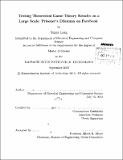Testing theoretical game theory results on a large scale : prisoner's dilemma on Facebook
Author(s)
Long, Sunny (Sunny X.)
DownloadFull printable version (4.805Mb)
Other Contributors
Massachusetts Institute of Technology. Department of Electrical Engineering and Computer Science.
Advisor
Constantinos Daskalakis.
Terms of use
Metadata
Show full item recordAbstract
In my research, I designed and implemented an online game accessable to a large diverse audience via the Facebook social network to test out game theoretic results and study social interactions. In this game, we designed scenarios that mirrored classic game theory situations, most prominantly the Iterated Prisoner's Dilemma game. The game allows for Facebook users to play each other in the Prisoner's Dilemma game while competing for a common goal. We then gather data on strategies employed by players and compare them to classic game theoretic results and try to explain similarities and differences. We also look at social factors that were prominant in decision-making for players. Analysis includes disecting which factors (e.g. gender, age, etc.) affect players' decisions and understanding winning strategies. We discovered that under the social setting of the experiment, factors that came into play for users' decision-making included gender as well as potential payoffs. On the other hand, game play history and whether or not two people were friends were not significant in decision-making. Despite a high overall cooperation rate (over 70%), the top players predominantly betrayed their opponents while never playing the same opponent too many times. The game is implemented in Ruby on Rails while all data analysis is done via Python scripts.
Description
Thesis: M. Eng., Massachusetts Institute of Technology, Department of Electrical Engineering and Computer Science, 2013. Cataloged from PDF version of thesis. Includes bibliographical references (pages 77-79).
Date issued
2013Department
Massachusetts Institute of Technology. Department of Electrical Engineering and Computer SciencePublisher
Massachusetts Institute of Technology
Keywords
Electrical Engineering and Computer Science.